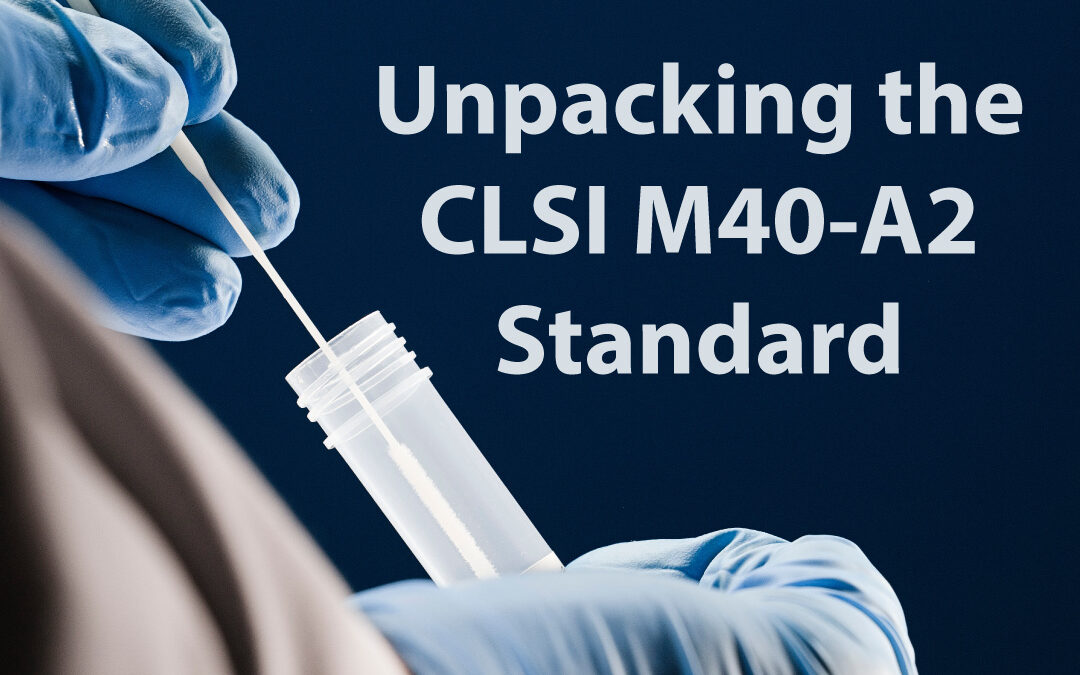In the scientific and medical communities, the accuracy of specimen collection and transportation is crucial. For example, if the transport conditions are not adequately maintained, such as incorrect temperature or delays in transportation, it can cause degradation of the sample. This degradation might render the specimen unusable or lead to inaccurate test results, potentially impacting patient diagnosis and treatment.
The M40-A2 standard, a guideline established for evaluating swab transport systems, plays a vital role in ensuring the reliability of these processes. This blog delves into the M40-A2 standard, highlighting its significance and application for virus transport.
What is M40-A2?
The Clinical and Laboratory Standards Institute (CLSI) is an organization that develops guidelines and standards to ensure high-quality and effective practices in clinical and laboratory environments. And M40-A2 is a set of guidelines created by the CLSI for swab transport systems. These systems are used to collect and carry samples, like bacteria and viruses, from the collection site to the testing laboratory. The M40-A2 standard gives detailed instructions on how these systems should be designed, how they should perform, and how they should be tested. This is to ensure that the microorganisms in the samples remain in good condition during their journey to the lab.
When a transport system is compliant with the M40-A2 standard guidelines, it means it can keep test samples in good condition throughout their journey to the lab. Manufacturers of these systems have to conduct strict tests on multiple batches, using the rules set out by the M40-A2 standard. This is to make sure that the systems are reliable and safe for use.
How We Test Virus Transport Systems Using the M40-A2 Standard
What is measured?
Our main focus is to check if the transport medium maintains the viability and infectivity of various viruses over time and under different temperatures. In the M40-A2 standard, the readout is immunofluorescence, whereby at the end of the experiment infected cells are stained for a viral antigen, to determine changes in the percentage infection compared to Time Zero.
Another important requirement is that the percentage infection at Time Zero is in the 40–50% range. This is important to ensure that the reading is performed in the linear range of the assay, and often, a pilot study is required for each transport media to determine the dilution of virus to use.
Also, we make sure this medium doesn’t harm the host cells used for virus cultivation in the lab (cytotoxicity test).
How we assess a product’s lifespan?
To adhere to this standard, we need to test three different lots of transport devices: one lot that’s new, one that’s in the middle of its shelf-life, and one that’s almost expired. This way, we can be confident that the devices work well at all stages of their shelf-life.
What virus types do we use?
We employ specific virus types from renowned suppliers as mandated by M40-A2. We work with a wide array of pathogens, such as influenza A and B, RSV, adenovirus, human coronaviruses, Rhinovirus, and human cytomegalovirus. It’s also crucial to introduce high concentrations of viruses into the transport systems; this is because we should replicate the substantial viral loads typically encountered in clinical specimens. Such a procedure ensures that the transport systems are evaluated under conditions that closely resemble real-world medical scenarios.
What temperatures do we test in the M40-A2?
A critical aspect of the M40-A2 test involves understanding how different temperatures affect viral infectivity in the virus transport system. These swab systems in contact with the virus are assessed at two distinct temperatures: a cooler 4°C and a controlled room temperature of 22–25°C. This is crucial for evaluating transport system stability and effectiveness under varied conditions.
Assessing Viral Infectivity Over Time
To assess the transport systems’ efficiency, viral infectivity is generally evaluated at four time intervals: immediately (time zero) and after 24, 48, and 72 hours. At time zero, we also initially “spike” our cell culture media with the same amount of virus that we add to the transport medium. This process, done before the study starts, helps us set a clear benchmark for what we consider ‘no reduction’ in virus infectivity.
To ensure reliable results, for every batch of transport system tested, three tubes are used for each of the four time points. This is important to account for any variations that might occur in individual tests or tubes.
Here’s what we expect to see at different time intervals:
- At Time Zero (0 hours): Ideally, there should be no reduction in virus infectivity by the virus incubated with the transport system compared to the control (virus incubated with the media). This is our baseline for comparison with the other time points.
- After 24 hours: It’s acceptable to see up to a 25% decrease in viral infectivity compared to Time Zero.
- After 48 hours: A reduction of up to 50% in viral infectivity compared to Time Zero is within the permissible range.
- After 72 hours: At this point, the M40-A2 standard allows for up to a 75% reduction in viral infectivity compared to Time Zero.
Although these guidelines are recommended by the standard, regulatory bodies typically permit the device manufacturer to determine the specific reduction thresholds. Therefore, we collaborate closely with our customers throughout the testing process to prepare a comprehensive final report that details the characteristics of the transport systems.
Our team has extensive experience in performing M40-A2 tests for viral transport, working with a variety of companies, particularly those in the process of compiling and submitting data to the US Food and Drug Administration regarding their Viral Transport Media (VTM).
We provide Good Laboratory Practice (GLP) reports, ensuring that our clients receive detailed, compliant, and reliable documentation to support their FDA submission process.
If you’re in need of expert testing services for your transport media, particularly for virus transport, please don’t hesitate to contact our friendly team.




